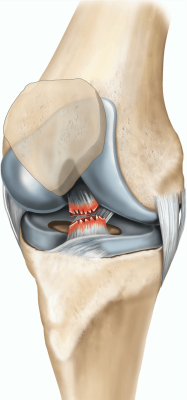How do I use telehealth extras benefits?
Learn about claiming telehealth benefits on your extras cover. We’re here to help with this short explainer.
Your anterior cruciate ligament (ACL) runs through the centre of your knee to connect your thigh bone (femur) to your shin bone (tibia).
ACL injuries occur when the leg twists or hyperextends under force. Abrupt changes in direction are a common cause of ACL injuries. Football, rugby and basketball are just some of the sports that place a high demand on the ACL with their cutting and sharp directional changes. These can lead to ACL tears as can contact injuries.
Any tearing or rupture (where the ligament severs in half) makes the knee unstable. You’ll have to put a stopper on your universally adored dance moves and sporting exploits until you get it sorted.

A torn ACL. Source: HealthDirect.gov.au
You may hear or feel something pop and then feel sudden pain and weakness in your knee.
The level of pain you feel will probably tell you whether you go straight to emergency hospital or head home to organise a physio or doctor appointment.
While ACL damage might be your first thought, the ACL is just one of four ligaments that supports the knee. Add to that potential damage to the meniscus that provides the cushion for the knee joint to function smoothly without bone-on-bone contact. Not to mention the surrounding muscles that can tear and bones that can suffer fractures and breaks.
In short, self-diagnosis probably isn’t an option, you’ll need some help. Here is your next choice: hospital or head home.
1. Emergency department.
The doctors at emergency will assess you and provide you with your next steps.
2. Head home to plan your next move.
Elevate your leg and keep it at a comfortable angle, perhaps with a pillow under your knee.
Many physios still advise applying ice to your injury straight away.
Ice eases pain, swelling and discomfort, especially if applied shortly after the injury occurs. Pain and discomfort may be your biggest concerns early on in an injury, so it’s well worth considering.
The doubt that has been rising is whether ice delays the healing process. Some studies show that ice may delay the natural healing process for ankle injuries. Just be aware that the standards for treating injuries may change in future as more evidence comes out.
One of the advantages of visiting a GP first is that they can refer you to an MRI scan covered for free under Medicare while a physio cannot.
Once your doctor checks your results, you can see what damage has been done and whether surgical options are needed or worthwhile.
From there your doctor can advise you if you’re ready for physio treatment. Just be prepared to check in your pride at the door. You may not realise it yet, but your physio thinks your glutes, quads, calves and hamstrings are the most pathetic cluster of underused muscles on the planet.
An ACL repair (also called ACL reconstruction) is an operation that seeks to return your ACL to full function by adding a tendon graft from elsewhere your body and using it to reconnect your broken ACL.
Not all ACL injuries require surgery. Some people with ruptured ACLs may choose not to have them repaired if they give up sports with lots of directional changes. Your doctor will have more information specific to your situation.
ACL repairs in Australia increased per head of population by 43% from 2000 to 2015, according to The Medical Journal of Australia. Australia has the highest rate of ACL repairs in the world.
Average private hospital cost in detail
| ACL Reconstruction | Without PHI | With PHI (with Access Gap and without) | With PHI and Access Gap |
|---|---|---|---|
| Average cost | $10,449 | $10,449 | $9,734 |
| Out of pocket | $10,449 | $2,337 | $1,803 |
| Savings with PHI | - | $8,112 | $8,646 |
About the data
All Peoplecare hospital covers* provide benefits towards:
Peoplecare pays a minimum of 25% of the Medicare Benefits Schedule fees towards specialist fees.
Before you go in for ACL repair, ask your doctors to participate in Access Gap to reduce your out-of-pocket expenses. Ask also for an itemised quote (called Informed Financial Consent in the Australian health system), this will show you what your out-of-pocket expenses. Get all the info in our Going to Hospital Guide.
Find doctors with a history of participating in Access Gap here.
*Waiting periods may apply. Public hospital cover only covers ACL repairs in public hospitals.

Learn about claiming telehealth benefits on your extras cover. We’re here to help with this short explainer.

Know that your mental health could be stronger but you’re not ready to take the big step to face-to-face help? Want to see if you could benefit from some of the types of techniques that professionals use?

To be covered or not to be covered? Hospital only? Extras only? Combo? There’s a lot to consider, so we’re here to make it easier.